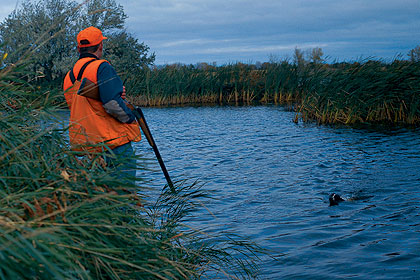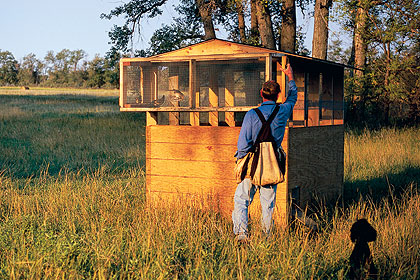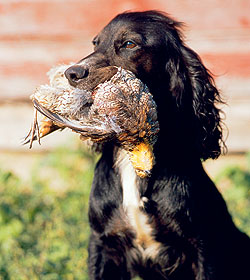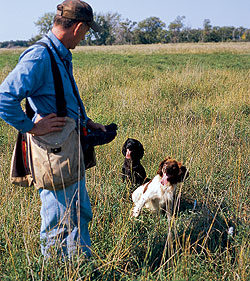A gun dog is only as good as its mentor
By Tom Davis
There's a section in Thomas Quinn's magisterial The Working Retrievers in which he recalls a long trip home to northern California from a field trial in the Midwest, a trial that had gone badly for Quinn and his Labradors. Determined to purge the bitter memories, he takes his dogs pheasant hunting the very next day.
A rooster gives him a long, tough chance, but while he hits it hard, it sails across an irrigation ditch into a stand of heavy tules. Deep in the tules themselves, Quinn's dogs are in no position to mark the fall.
He calls them in, sets them up for the "blind," and, giving each of his three (or maybe four) black Labs a slightly different line, sends them one by one in search of the cripple.
An artist by profession but a gifted writer as well, Quinn likens himself to an archer pulling arrows from his quiver--the last of which strikes the bull's-eye. When his dog comes up with the bird, the satisfaction is profound. And, in that luminous moment, Quinn's lingering demons are exorcised.
It's not exactly déjà vû all over again (to quote the eminent philosopher Yogi Berra), but as I accompany Tom Ness and his dogs over the rolling prairies of North Dakota I can't help but think of the Quinn passage. Ness, you see, had also traveled halfway across the continent to a field trial, this one in Maine, only to have his dogs--cocker spaniels that are normally in the thick of the fight--come to utter ruin. He'd pulled in to his Oahe Kennels in Menoken (near Bismarck) late the night before; after stopping by the guest lodge where he houses visiting "sports" just long enough to say hello to John McMahon and me (and cut the dust with a cold one), he toddled off to bed.
 Tom Ness hunting snipe near his North Dakota kennels with one of his English cockers. |
Murphy gets his chance, too, sweeping the open prairies--a pointing dog's proper milieu--with a flowing stride and a forward, easy-handling pattern. An intense point produces a single sharptail, one of the few still hanging out in the grass. But the gun on that side of the line doesn't hold up his end of the bargain, and the bird fades into the shimmering distance, the sound of its familiar gurgling clucks--kuk-kuk-kuk-kuk-kuk, kuk-kuk-kuk-kuk-kuk--borne away on the warm south wind.
In The Field
Now, less than 72 hours after their field trial debacle, Ness and his dogs are putting on a world-class show--to the detriment of the local sharp-tailed grouse population. He's running a brace of cockers, bouncy, honey-blonde Shelby and jet-black, jet-propelled Cassie; a diligent young black Lab, Bramble, that he brought back from a recent trip to the UK; and Murphy, a handsome and stylish Irish setter that he's polishing up for a client. The September sun is high, and with the temperatures climbing above 80 degrees, the sharptails are hunkered in the thickets and windbreaks, seeking shade. It's a perfect scenario for the flushing dogs, and while the rest of the pack walk obediently at heel, the dog Ness "taps"--simply by calling its name--works the cover.
In point of fact, the cockers don't work the cover so much as they shred it. You half-expect the grass to catch fire in their wake. They also display perfect manners at flush and shot ("Why couldn't you do that in Maine, you [bleep]?" Ness grouses), allowing him to send Bramble, who needs the experience and reinforcement more than they do, for the retrieves.
"Pretty nice, eh, Davis?" Ness asks, a sly smile on his lips, as Bramble delivers another "chicken" to hand.
"Damn nice, Ness," I respond, proffering my water bottle so that the four-legged members of the team can take a well-deserved drink.
Topping a rise, we come to a gently sloping hillside that frames the golden stubblefield below. "Davis, get above that bush," Ness directs, gesturing toward a small plum thicket about 50 yards ahead. I circle around, giving the thicket a wide berth, and when I'm in position Ness says, "Cassie."
 Tom Ness releases quail from one of his "johnny houses." |
It's as if he's launched a missile (a contemporary spin on the arrow-quiver theme), and it has the same effect. When the black cocker hits the bush it literally seems to explode, to disintegrate and fly apart; grinding hard to process this contradictory information, my brain finally sorts it out.
Huns!
They're swarming out of the thicket like mutant bees, the roar of their wings and their chalk-on-slate chittering adding to the sensory overload. Somehow, though, I regroup in time to make a couple decent swings with my vintage Fox 16 and leave the covey two birds lighter.
"Nice shooting," says Ness, bending to take one plump Hun from Cassie, another from Shelby.
"Thanks. The way those birds came out of there--man! I felt like I was shooting in self-defense."
It was a fitting climax to one of the most thoroughly enjoyable days of upland bird hunting I've had in a long, long time. The dog work, in particular, had been extraordinary. Most of us have our hands full handling one dog in the field; Ness handled four, and made it look easy. This is the kind of thing you read about--at least if you read people like the iconoclastic British gun dog authority Keith Erlandson ("He's quite mad, you know," another Brit once told me)--but never expect to experience in the flesh.
Unless you hunt with Tom Ness, that is. Although a native-born son of the Great Plains--he grew up in Grand Forks in a family of boxers (he fought in the amateur ranks himself) and cribbage players, and worked as an oil shale geologist in Colorado before turning pro--his approach to dog training is emphatically British. You'll look in vain for an electronic collar ("I had one," Ness'll tell you, "but it broke"); when a cocker commits an infraction he runs it down, picks it up, and bites its ear to get his point across.
That's not a training technique he learned on this side of the pond, I assure you.
No, the trainers Ness has taken his cues
from are the cranky, colorful Brits like Erlandson and Cyril Gwnne, whose Wernffrwd Kennels are comparatively little-known in America but legendary in the UK. Like them, Ness is keenly observant, shrewdly perceptive, and utterly his own man.
Like them, too, he's outspoken to a fault: At a springer trial he judged not long ago, he told the crowd assembled for the announcement of the placements that while the first place dog was deserving, the rest of the field basically stunk. You could have heard a pin drop, except for the sound of jaws dropping. (His judging calendar opened up considerably after that.)
With Tom Ness, what you see is what you get--but for all his Anglophilia, one thing you will never see is Ness affecting the British fashion and donning tweeds, Wellies, and a grouse helmet. Frankly, his wardrobe could stand some improvement; when I saw the ratty, threadbare vest he was wearing at the National Cocker Championship a few year ago, I was so appalled I called Filson ASAP and ordered him a new one. I wonder what the hell happened to it.
 Cassie proudly displays the result of a training session. |
The Professional Ranks
Ness turned pro in the mid-1980s, and has been at it full-time since surviving a near fatal shooting accident in 1992. (A word to the wise: If he offers to show you the pictures, run. Run fast.) He started out with springers, but by the early '90s had switched his emphasis to cockers. Indeed, Ness was in on the ground floor of the "cocker renaissance" here; his bitch Parkbreck Elm of Bishwell--"Mave," to those who knew her--was the second cocker in the modern era to earn an American field championship.
He's trained and handled a lot of champions since then, notably Gilly Daydream (who John McMahon and I had a blast gunning snipe over on our first trip to Ness's place in 1997), Oahe Sentinel, Krosswinds Ricochet, Oahe Penelope, and Warrener's Black Scoter. The last two dogs, both owned by Hobson Brown, finished numbers one and two, respectively, in the 2005 high point standings.
"Cocker trials in this country are right where they should be," states Ness. "In the cocker world, there's no difference between a field trial dog and a gun dog. The cockers that win field trials are just the best trained and classiest of the bunch. They're the same dogs you'd want to hunt with."
Having had the pleasure of hunting behind a number of Ness's field trial winners, I can enthusiastically attest to that.
Another contention of Ness's that I tend to agree with is that the overall quality of cockers in this country--hunting cockers, I mean--is higher than that of any other gun dog breed.
"They haven't been here long enough for us to screw 'em up," he explains, noting that very few cockers in America are more than a couple generations removed from the UK.
"But it's only a matter of time.
"Look at what's happened to the Labrador. Whenever I get a call from someone who wants me to train a Lab that's out of American field trial bloodlines, I cringe. British Labs have all the desire to hunt and retrieve that you'd ever want in a gun dog, and they're so much calmer and more biddable. It's just about gotten to the point where they're the only Labs I'll take for training."
Somewhere, Keith Erland-son--who famously defined a proper gun dog as one that can be shot over "without irritation"--is smiling.
The Obedience Factor
Not surprisingly, Ness is a firm believer in starting with a heavy dose of obedience training, then using that foundation as a platform for the transition to the field. Again, it's the typical British approach--and 180 degrees opposed to what most Americans do, which is to start killing birds over their dogs as soon as possible, and in the process not only allow but encourage them to chase at flush and shot.
"That's why we call it 'breaking' here, while in Britain it's called 'steadying,'" says Ness. "We 'break' the dog of a bad habit that in fact we've created. It's totally backwards."
He visited the UK last spring, and speaks in glowing terms of what British cocker trainers--mostly amateurs, mind you--are able to accomplish in their yards. "Most of these guys don't have any birds," he says. "Some of them might have a few rabbits, but mainly they just use dummies, or even tennis balls. But their dogs are trained perfectly.
"What Americans don't understand is that the desire and the instincts are already there.
 Two of Tom Ness's "students" gives their teacher their full attention. |
When we were in the UK Cyril Gwynne had just been to his first field trial in nine years--and his dog had won it. The guy I was with, another American, asked him how many birds he'd given his dog before the trial. Cyril sort of looked at him funny and said, 'Why, not a one.'
"I make a distinction between bird dogs and gun dogs. A big-running pointer or setter, for example, is a bird dog. It hunts for birds. But a cocker, or any other flushing breed, is a gun dog. It hunts for the gun--which is why obedience training is so important."
But if Ness is a traditionalist, he's in equal measure an innovator. Taking a page from the pointing dog book, for the past few years he's been training extensively on bobwhite quail, quail that live in large recall pens--a.k.a. "johnny houses"--and, when "flighted," behave very much like wild birds.
"I don't know any other spaniel trainers who use johnny houses," Ness tells John McMahon and me as, with a brace of hupped cockers watching intently, we release a covey's worth of bobs into the tangled woodlands behind the home he shares with his wife, Robin (an accomplished trainer in her own right). "And I don't know why. The birds have no human scent, they fly well, they go to the places wild birds would go--it's about as close to actual hunting as you can get. I just wish I'd started doing it 10 years ago."
With that, Ness quietly says "Oscar," and a bolt of black lightning streaks from his side and attacks the cover. "This is Warrener's Black Scoter," Ness informs us. "He was the number two cocker in the country last year, but he broke on me in Maine."
John and I are toting our smoothbores, with instructions to shoot to kill. Easier said than done, we discover: The quail don't merely fly well, they fly spectacularly well. It's like early season ruffed grouse shooting, except the birds are 1„4
-size.
Still, we manage to scratch down a few--and when Oscar takes an unbidden step on one, he earns a bite on the ear for his indiscretion. Chastened but unfazed--"A cocker should be a bit of a scamp," says Ness's mentor Cyril Gwynne--Oscar vibrates like a tuning fork until Ness releases him.
We wend our way toward the next johnny house. "I had a cocker in for training that did everything right," Ness recounts, "except she'd cast behind you more often than not. I tried everything I could think of, but I couldn't get her to stay to the front.
"Then one day I had her on hup while I flighted some quail. They all flew straightaway, and as she watched them go you could almost see the light go on. It was as if she said to herself, 'So that's where the birds are.' From that moment on, she cast ahead and hunted right where she was supposed to."
Conclusion
We spend the rest of the morning putting various dogs through their paces, including Bishop, John McMahon's promising young cocker. "That a nice dog you've got there, McMahon," says Ness. "You could field trial that dog." Then, with a group of clients arriving that afternoon for a few days of Hun and sharptail hunting, we say our goodbyes and head on down the road.
"Thank God he didn't make us look at his photos again," McMahon says shortly after we've turned on to the highway.
"Amen, brother," I say.






